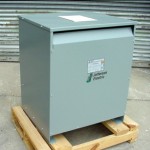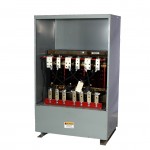The Venerable Small Dry Type Transformer or (can I get your shipping address sir)
The small dry-type transformer – what can one say about these marvels? They come close to achieving the perfect combination of form and function. Designed to be cooled by movement of air, not moving water, the dry type transformer is perfect for indoor use or anywhere that it can be sheltered from the elements: porches, below lean-tos or beneath small structures. There are some with optional rain ‘gutters’ intended to direct water away from the transformer coils. Wherever they are found, the dry type transformer, one of the most common type of transformers seen today. It is the ubiquitous work horse of the industry. The three phase 480 Volt Delta to 240 Volt Delta, from between 50 to 150 KVA, are among the most popular. As many utilities have moved to away from offering 240 Volt services, they are commonly used to transform the incoming 480 Volts to power 240 Volt equipment. Most are designed so you can usually run them backwards to produce 480 volts from 240 volts. What happens when this very reliable workhorse fails? No spare readily available, you obtain a replacement. Right?
But why wait till then? It would be good practice if they were looked at occasionally, once installed, but small transformers of this type are typically not tested during routine plant shutdowns. So they are frequently used as tables, workbenches, shelves, ladders or stationary hotplates to keep lunches and bakery warm. There are usually indicators well in advance of a transformer’s doom. Little warning signs that if left uncorrected will lead to failure; excessive noise, excessive vibration, the usually warm transformer gradually becomes hot to the touch transformer. If you look underneath one and see only dusty clogged vents, chances are it is running at a higher temperature than recommended.
At MIDWEST we perform an insulation resistance test and load test on all of our reconditioned transformers before they leave our door.
Meanwhile take care of the dry type transformers you are presently using. Be smart and keep them free and clear from clutter, dirt and moisture…
The good news is if the need for replacement arises, you can usually find something to take the place of the one you just lost. You can buy a new one from us because the manufacturers still make them or you can ask us for a quote on a reconditioned transformer.

